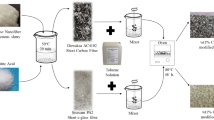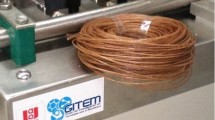Abstract
In the recent years, additive manufacturing (AM) has been widely expanded for manufacturing the polymer and polymer-based composite parts. The main drawback of the material extrusion additive manufactured parts is the weaker mechanical properties in comparison to the manufactured parts by the conventional methods. The stated weak mechanical properties are due to the weak adhesion between the deposited layers. The poor adhesion between the deposited layers in material extrusion additive manufacturing process is due to the fact that the previous deposited filament (n-1) is already cooled and solidified. To ensure the appropriate adhesion between the two adjacent filaments, the temperature of the first deposited layer (n-1) has to be high enough to obtain a suitable adhesion to the subsequent layer (n) but in an optimum range to avoid the lack of the dimensional accuracy. Therefore, a precise and local measurement of the temperature on the scale of the diameter of the filaments is necessary. In this study, four important process parameters (liquefier temperature, layer height, print speed, and bed platform temperature) were selected to study their effects on the rheological behavior and temperature evolution of the PA6 and CF-PA6 materials during material extrusion process. Then, the impact of the short/chopped reinforcement on the thermal and mechanical properties of the material extrusion additive manufacturing processed polymer-based composites were studied by comparing the obtained results from PA6 and CF-PA6 parts. In one experiment, it was observed that increasing the liquefier temperature from 220 to 240 °C increased the tensile strength and crystallinity percentage of the manufactured PA6 and CF-PA6 specimens. It was determined that the crystallinity percentages of PA6 and CF-PA6 specimens increased from 12.51 to 14.40% and from 19.97 to 20.51%, respectively. One of the existence effects of carbon fibers is highlighted in the higher crystallinity values of the CF-PA6 specimens comparing PA6 specimens. Finally, a time–temperature-transformation diagram was plotted to determine the processability condition of the utilized materials. It can be helpful for the designers and researchers to find out the optimal material extrusion additive manufacturing process parameters condition for the utilized raw materials.

























Similar content being viewed by others
References
Standard, A. S. T. M. (2012) F2792. 2012 Standard terminology for additive manufacturing technologies. ASTM International, West Conshohocken. See www.astm.org. https://doi.org/10.1520/F2792-12
Ahmadifar Mohammad et al (2021) Additive manufacturing of polymer-based composites using fused filament fabrication (FFF): a review. Appl Compos Mater 28:1335–1380
Górski FILIP, Kuczko WIES, Wichniarek RADOSŁAW (2014) Impact strength of ABS parts manufactured using fused deposition modeling technology. Arch Mech Technol Autom 34(1):3–12
Baich L, Manogharan G, Marie H (2015) Study of infill print design on production cost-time of 3D printed ABS parts. Int J Rapid Manuf 5(3–4):308–319
Ahmadifar M, Benfriha K, Shirinbayan M (2023) Thermal, tensile and fatigue behaviors of the PA6, short carbon fiber-reinforced PA6, and continuous glass fiber-reinforced PA6 materials in fused filament fabrication (FFF). Polymers 15(3):507
Ahn Daekeon et al (2012) Quantification of surface roughness of parts processed by laminated object manufacturing. J Mater Proc Technol 212(2):339–346
Wang Jie et al (2016) Stereolithographic (SLA) 3D printing of oral modified-release dosage forms. Int J Pharm 503(1–2):207–212
Greiner Sandra et al (2017) Selective laser sintering of polymer blends: bulk properties and process behavior. Polymer Test 64:136–144
Turner BN, Strong R, Gold SA (2014) A review of melt extrusion additive manufacturing processes: I Process design and modeling. Rapid Prototyp J 20(3):192–204
Yeole P et al (2020) Mechanical characterization of high-temperature carbon fiber-polyphenylene sulfide composites for large area extrusion deposition additive manufacturing. Addit Manuf 34:101255
Ning F et al (2017) Additive manufacturing of carbon fiber-reinforced plastic composites using fused deposition modeling: effects of process parameters on tensile properties. J Compos Mater 51(4):451–462
Wong KV, Hernandez A (2012) A review of additive manufacturing. ISRN Mech Eng 2012:1–10
Li N, Li Y, Liu S (2016) Rapid prototyping of continuous carbon fiber reinforced polylactic acid composites by 3D printing. J Mater Process Technol 238:218–225
Zhang J et al (2019) Molding process and properties of continuous carbon fiber three-dimensional printing. Adv Mech Eng 11(3):1687814019835698
Tian X et al (2016) Interface and performance of 3D printed continuous carbon fiber reinforced PLA composites. Compos Part A Appl Sci Manuf 88:198–205
Mori K-I, Maeno T, Nakagawa Y (2014) Dieless forming of carbon fibre reinforced plastic parts using 3D printer. Procedia Eng 81:1595–1600
Nakagawa Y, Mori K-I, Maeno T (2017) 3D printing of carbon fibre-reinforced plastic parts. Int J Adv Manuf Technol 91(5):2811–2817
Namiki M, Ueda M, Todoroki A, Hirano Y, Matsuzaki R (2014) 3D printing of continuous fiber reinforced plastic. In: SAMPE Tech Seattle 2014 Conference. Soc. for the Advancement of Material and Process Engineering
Wu S et al (2019) 3D-printed chiral metasurface as a dichroic dual-band polarization converter. Optics Lett 44(4):1056–1059
Wang X, Jiang M, Zhou Z, Gou J, Hui D (2017) 3D printing of polymer matrix composites: a review and prospective. Compos Part B Eng 110:442–458
Too MH et al (2002) Investigation of 3D non-random porous structures by fused deposition modelling. Int J Adv Manuf Technol 19(3):217–223
Masood SH, Rattanawong W, Iovenitti P (2000) Part build orientations based on volumetric error in fused deposition modelling. Int J Adv Manuf Technol 16(3):162–168
Zander NE, Gillan M, Lambeth RH (2018) Recycled polyethylene terephthalate as a new FFF feedstock material. Addit Manuf 21:174–182
Chong S et al (2017) Physical characterization and pre-assessment of recycled high-density polyethylene as 3D printing material. J Polym Environ 25(2):136–145
Pakkanen J, Manfredi D, Minetola P, Iuliano L (2017) About the use of recycled or biodegradable filaments for sustainability of 3D printing. State of the art and research opportunities. Sustainable Design and Manufacturing 2017: Selected papers on Sustainable Design and Manufacturing 4:776–785
Tekinalp HL et al (2014) Highly oriented carbon fiber–polymer composites via additive manufacturing. Compos Sci Technol 105:144–150
Fu S-Y et al (2000) Tensile properties of short-glass-fiber-and short-carbon-fiber-reinforced polypropylene composites. Compos A Appl Sci Manuf 31(10):1117–1125
Fu S-Y, Lauke B (1996) Effects of fiber length and fiber orientation distributions on the tensile strength of short-fiber-reinforced polymers. Compos Sci Technol 56(10):1179–1190
Costa AE, da Ferreira Silva A, Sousa Carneiro O (2019) A study on extruded filament bonding in fused filament fabrication. Rapid Prototyp J 25(3):555–565
Shofner ML et al (2003) Nanofiber-reinforced polymers prepared by fused deposition modeling. J Appl Polym Sci 89(11):3081–3090
Benfriha K, Ahmadifar M, Shirinbayan M, Tcharkhtchi A (2021) Effect of process parameters on thermal and mechanical properties of polymer-based composites using fused filament fabrication. Polym Compos 42(11):6025–6037
Brenken B et al (2019) Development and validation of extrusion deposition additive manufacturing process simulations. Addit Manuf 25:218–226
Gupta A et al (2020) Processing, mechanical characterization, and micrography of 3D-printed short carbon fiber reinforced polycarbonate polymer matrix composite material. Int J Adv Manuf Technol 107(7):3185–3205
Choi Y-H et al (2016) Influence of bed temperature on heat shrinkage shape error in FDM additive manufacturing of the ABS-engineering plastic. World J Eng Technol 4(3):186–192
Ning F et al (2015) Additive manufacturing of carbon fiber reinforced thermoplastic composites using fused deposition modeling. Compos Part B Eng 80:369–378
Zhong W et al (2001) Short fiber reinforced composites for fused deposition modeling. Mater Sci Eng A 301(2):125–130
Stoof D, Pickering K (2018) Sustainable composite fused deposition modelling filament using recycled pre-consumer polypropylene. Compos B Eng 135:110–118
Author information
Authors and Affiliations
Corresponding author
Ethics declarations
Ethics approval
All the authors declare that this paper did not need ethics approval.
Consent to participate
Not applicable.
Consent for publication
Not applicable.
Conflict of interest
The authors declare no competing interests.
Additional information
Publisher's note
Springer Nature remains neutral with regard to jurisdictional claims in published maps and institutional affiliations.
Rights and permissions
Springer Nature or its licensor (e.g. a society or other partner) holds exclusive rights to this article under a publishing agreement with the author(s) or other rightsholder(s); author self-archiving of the accepted manuscript version of this article is solely governed by the terms of such publishing agreement and applicable law.
About this article
Cite this article
Ahmadifar, M., Shirinbayan, M. & Benfriha, K. Investigation of the impact of the short fiber reinforcements on the thermal and mechanical properties of polymer-based composites manufactured by material extrusion. Int J Adv Manuf Technol 127, 3801–3817 (2023). https://doi.org/10.1007/s00170-023-11758-7
Received:
Accepted:
Published:
Issue Date:
DOI: https://doi.org/10.1007/s00170-023-11758-7




